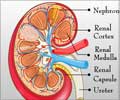Scientists have revealed that high blood pressure takes a toll on glomeruli, which are small filtering units in the kidney.
While the kidney is known to filter about 200 quarts of plasma daily, eliminating about two quarts of waste product and extra water as urine, scientists are still clueless of the physiology behind the whole process.Dr. Edward W. Inscho, physiologist in the Medical College of Georgia Schools of Medicine and Graduate Studies challenged colleagues to fill in important blanks in how this process works normally and how to make it work better in disease
But the scientists are sure that hypertension takes a serious toll on the kidneys and damaged kidneys worsen hypertension.
According to Inscho, the kidneys' million hard-working filters, or glomeruli, are direct victims of high pressure. His research focuses on the minute arteries, or arterioles, that feed blood into each of them. These afferent arterioles are responsible for keeping blood pressure at a comfortable 60 mmHg inside glomeruli.
At a healthy blood pressure of 120/80 mmHg, blood enters the artery at a mean pressure of 100 mmHg, but higher pressures mean the arterioles must work even harder to reach the 60 mmHg target. At least initially they seem up to the task at least initially, contracting to make it harder for blood to pass and reducing pressure in the process.
"We want to know how it does that," said Inscho while watching the near instantaneous contraction.
Advertisement
"It's an action-reaction kind of event," he said.
Advertisement
University of Southern California researcher Dr. Janos Peti-Peterdi thinks high pressures tugging the tethers connecting smooth muscle cells to others in the blood vessel wall may really be what releases ATP, a theory supported by Inscho.
It may be that hypertension changes the attachment of those tethers so they don't respond and the blood vessel can't either.
"We are trying to figure out how all this fits together," said Inscho.
He added that knowing the critical steps of this "amazingly elegant, amazingly precise and very complicated" process will lead to better understanding of what gets corrupted by diseases such as hypertension and diabetes and maybe how to stop kidney destruction.
He said that inflammation is also likely to play a big role.
"We know we can make these animals hypertensive, treat them with anti-inflammatories and prevent this whole process (of glomeruli destruction) from occurring. I think that's pretty exciting, but we don't know exactly how we are doing that," he said.
The findings of the study were presented during the Lewis K. Dahl Memorial Lecture at the 62nd High Blood Pressure Research Conference and Workshop in Atlanta.
Source-ANI
RAS/SK














